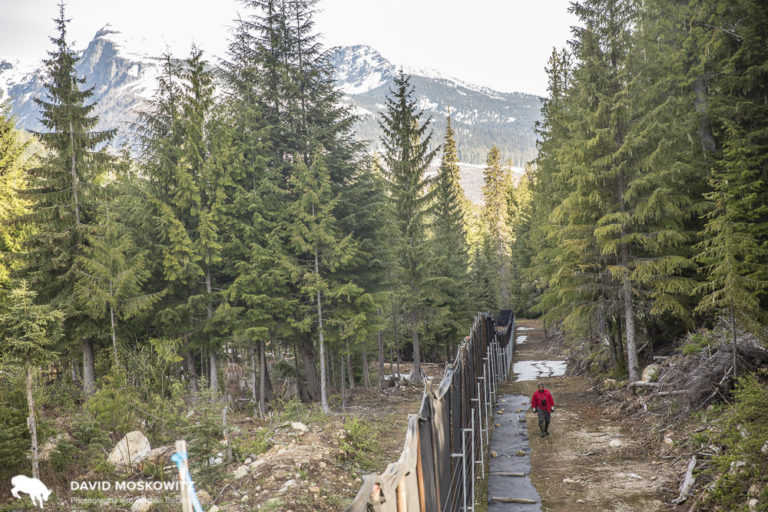One of the last mountain caribou left in the Southern Selkirks herd, photographed here in the Darkwoods Conservation Area owned by the Nature Conservancy of Canada. These caribou have been amazingly hard to track down.
By Kim Shelton and David Moskowitz
On our first in-person meeting, Norm Merz, wildlife biologist for the Kootenai Tribe of Idaho, met us at his office but soaked up to his knees from having already spent the better part of the morning walking through wet meadows for work. Previously, when I spoke to Norm over the phone, I could hear his smile as he expressed how much he cared about his work; “I love it”. But not all of the work of this biologist involves morning meadow romps. Saving a species on the brink of extinction involves a great deal of grueling work out of the field; planning, coordinating people, and securing funding.
The story of the South Selkirk herd of mountain caribou was the initial inspiration for the start of the Mountain Caribou Initiative. This is the only herd left that travels back and forth over the Canada-USA border and, as such, keep mountain caribou as clearly an American issue (besides the fact that USA corporations and consumers are responsible for much of the ongoing resource extraction on the Canadian side of the border affecting caribou). As of this April, there are just 11 caribou in the South Selkirk herd. Without emergency measures to reduce the rate at which adult animals are dying and increase calf survival rates, we are at a high risk of losing this herd entirely and permanently. Lead in large part by the initiative of the indigenous peoples of this region, planning for a maternity pen for this herd is underway for this coming spring.
Constructing a maternal pen is a lot of work, it costs a lot of money, and there’s no promise that it will actually succeed. No one benefits monetarily from trying to stop the extinction of this herd, but the people fighting for these animals are in it for another reason. “It’s a matter of the heart,” Merz admits. For the people of the Kootenai tribe and their neighbors, the Kalispel in northeastern Washington, its also an issue of cultural identity and survival.
Wildlife monitor Lenny Edwards, member of the Splatsin First Nation, walking the outside perimeter of the maternity pen north of Revelstoke BC.
Three pregnant mountain caribou safe inside the Revelstoke maternity pen.
Look closely to see the mountain caribou feeding inside the maternity pen in Revelstoke BC. The proposed pen in the Southern Selkirks would appear similarly and create a predator free environment for cows to give birth to young.
There are a lot of organizations involved in the project including tribes, First Nations, Provincial, State, Federal, and local governments, all of which have representatives on the Selkirk Caribou International Technical Working Group (SCITWG). This group is tasked with updating the 1994 recovery plan to stop the extirpation of the Southern Selkirks herd. One of the first things agreed upon by this group was that action needed to be taken even while a recovery plan was still being updated. Without immediate action, this herd will almost certainly go extinct before the planning process can be completed. “We’re to the point where we’ve gotta try everything we can,” says Merz.
An effort was made to initiate the maternal pen this spring but weather and bureaucratic red tape stymied the effort for 2017. However, things are looking promising for 2018. The pen is currently being constructed in preparation for capture work in March or April of 2018. However the budget to run the pen is just over $230,000 USD with most of these funds yet to be secured. Without these funds, the project won’t get off the ground.
Based on the most recent survey, there are currently only 6 cows in this tiny and shrinking herd to be captured and transported via helicopter to the 20 acre maternal pen on the Nature Conservancy of Canada property east of Ymir, British Columbia. They will be held for 3-4 months while they give birth, and will be released around mid-July when the calves are about a 6-8 weeks old. At the pen, a wall made of 15ft high geotextile fabric and electric fencing serve as both a visual barrier to protect the wildness of the caribou and as a deterrent to predators.
Volunteers with the Selkirks Conservation Alliance are hard at work collecting arboreal lichens to feed the caribou in the maternity pen next spring, like these caribou in the Kline-sa pen further north.
Merz explains that they would love to augment the South Selkirk herd with animals from other herds, to help with numbers and also with genetic diversity. However, with all of the southern mountain caribou herds populations in poor shape, additional caribou don’t appear to be available for augmentation at this point , even if those animals were exchanged back once the herd is bigger. At the very least the SCITWG is hoping that the pen will stabilize the population as appears to be the case with the North Columbia herd where maternity penning has been ongoing, if not succeed in increasing calf numbers as has happened with the Klinse-za herd in the South Peace region of BC which also had a maternity penning project.
Interested in donating to this endeavor? Send donations to Kootenai Tribe of Idaho – Charitable Conservation Fund, PO Box 1269, Bonners Ferry, ID 83805. There are no administration fees and donations may be tax deductible. Contact Norm Merz at merz@kootenai.org or 208-267-3620
See a video of some of the last caribou in the Southern Selkirks caribou herd we captured in the Nature Conservancy’s Darkwoods preserve during the summer of 2016:
https://vimeo.com/176074778
Learn about the Klinse-za maternity pen and watch a short video we produced about it: http://davidmoskowitz.net/2016/04/klinse-za-caribou-maternal-penning-project/
https://vimeo.com/161226373






